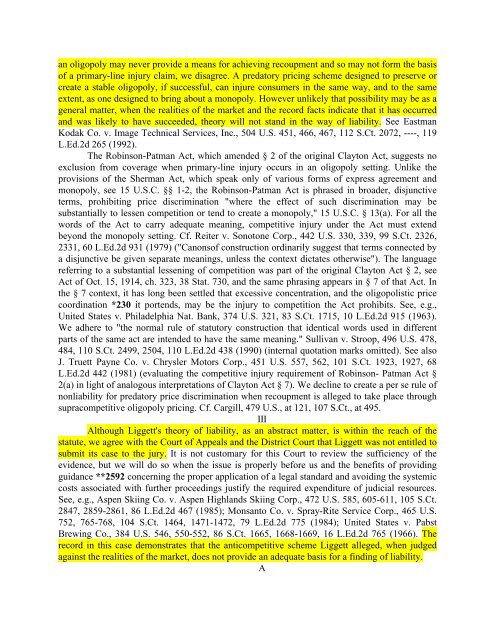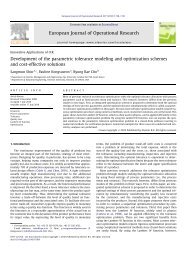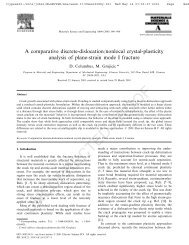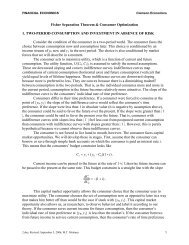509 U.S. 209, 113 S.Ct. 2578 BROOKE GROUP LTD., Petitioner v ...
509 U.S. 209, 113 S.Ct. 2578 BROOKE GROUP LTD., Petitioner v ...
509 U.S. 209, 113 S.Ct. 2578 BROOKE GROUP LTD., Petitioner v ...
Create successful ePaper yourself
Turn your PDF publications into a flip-book with our unique Google optimized e-Paper software.
an oligopoly may never provide a means for achieving recoupment and so may not form the basis<br />
of a primary-line injury claim, we disagree. A predatory pricing scheme designed to preserve or<br />
create a stable oligopoly, if successful, can injure consumers in the same way, and to the same<br />
extent, as one designed to bring about a monopoly. However unlikely that possibility may be as a<br />
general matter, when the realities of the market and the record facts indicate that it has occurred<br />
and was likely to have succeeded, theory will not stand in the way of liability. See Eastman<br />
Kodak Co. v. Image Technical Services, Inc., 504 U.S. 451, 466, 467, 112 S.<strong>Ct</strong>. 2072, ----, 119<br />
L.Ed.2d 265 (1992).<br />
The Robinson-Patman Act, which amended § 2 of the original Clayton Act, suggests no<br />
exclusion from coverage when primary-line injury occurs in an oligopoly setting. Unlike the<br />
provisions of the Sherman Act, which speak only of various forms of express agreement and<br />
monopoly, see 15 U.S.C. §§ 1-2, the Robinson-Patman Act is phrased in broader, disjunctive<br />
terms, prohibiting price discrimination "where the effect of such discrimination may be<br />
substantially to lessen competition or tend to create a monopoly," 15 U.S.C. § 13(a). For all the<br />
words of the Act to carry adequate meaning, competitive injury under the Act must extend<br />
beyond the monopoly setting. Cf. Reiter v. Sonotone Corp., 442 U.S. 330, 339, 99 S.<strong>Ct</strong>. 2326,<br />
2331, 60 L.Ed.2d 931 (1979) ("Canonsof construction ordinarily suggest that terms connected by<br />
a disjunctive be given separate meanings, unless the context dictates otherwise"). The language<br />
referring to a substantial lessening of competition was part of the original Clayton Act § 2, see<br />
Act of Oct. 15, 1914, ch. 323, 38 Stat. 730, and the same phrasing appears in § 7 of that Act. In<br />
the § 7 context, it has long been settled that excessive concentration, and the oligopolistic price<br />
coordination *230 it portends, may be the injury to competition the Act prohibits. See, e.g.,<br />
United States v. Philadelphia Nat. Bank, 374 U.S. 321, 83 S.<strong>Ct</strong>. 1715, 10 L.Ed.2d 915 (1963).<br />
We adhere to "the normal rule of statutory construction that identical words used in different<br />
parts of the same act are intended to have the same meaning." Sullivan v. Stroop, 496 U.S. 478,<br />
484, 110 S.<strong>Ct</strong>. 2499, 2504, 110 L.Ed.2d 438 (1990) (internal quotation marks omitted). See also<br />
J. Truett Payne Co. v. Chrysler Motors Corp., 451 U.S. 557, 562, 101 S.<strong>Ct</strong>. 1923, 1927, 68<br />
L.Ed.2d 442 (1981) (evaluating the competitive injury requirement of Robinson- Patman Act §<br />
2(a) in light of analogous interpretations of Clayton Act § 7). We decline to create a per se rule of<br />
nonliability for predatory price discrimination when recoupment is alleged to take place through<br />
supracompetitive oligopoly pricing. Cf. Cargill, 479 U.S., at 121, 107 S.<strong>Ct</strong>., at 495.<br />
III<br />
Although Liggett's theory of liability, as an abstract matter, is within the reach of the<br />
statute, we agree with the Court of Appeals and the District Court that Liggett was not entitled to<br />
submit its case to the jury. It is not customary for this Court to review the sufficiency of the<br />
evidence, but we will do so when the issue is properly before us and the benefits of providing<br />
guidance **2592 concerning the proper application of a legal standard and avoiding the systemic<br />
costs associated with further proceedings justify the required expenditure of judicial resources.<br />
See, e.g., Aspen Skiing Co. v. Aspen Highlands Skiing Corp., 472 U.S. 585, 605-611, 105 S.<strong>Ct</strong>.<br />
2847, 2859-2861, 86 L.Ed.2d 467 (1985); Monsanto Co. v. Spray-Rite Service Corp., 465 U.S.<br />
752, 765-768, 104 S.<strong>Ct</strong>. 1464, 1471-1472, 79 L.Ed.2d 775 (1984); United States v. Pabst<br />
Brewing Co., 384 U.S. 546, 550-552, 86 S.<strong>Ct</strong>. 1665, 1668-1669, 16 L.Ed.2d 765 (1966). The<br />
record in this case demonstrates that the anticompetitive scheme Liggett alleged, when judged<br />
against the realities of the market, does not provide an adequate basis for a finding of liability.<br />
A
















